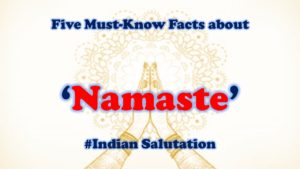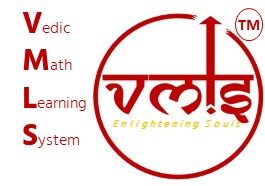
दीपो नाशयते ध्वांतं धनारोग्ये प्रयच्छति | कल्याणाय भवति एव दीपज्योतिर्नमोऽस्तुते ॥
Meaning, ‘The lamp destroys darkness, it brings health and wealth. Lamp is for the welfare of all humans. O flame of lamp, I bow to you.’
Here, we are praying the flame of the lamp which destroys the darkness. We must pray everything that destroys darkness. May it be the darkness or ‘ignorance’ or ‘ego’ or ‘anger’ or ‘greed’ or ‘one up Manship’. If we understand the wordy, spiritual, symbolic, ancient meaning of ‘Namaste’, It can act as the flame of light representing, true knowledge of life, compassion, love, respect and equality.
Namaste is a word, generally Indians use as a greeting salutation. If you see the ancient scriptures, you can notice the use of this word quite often. It is quite more possessing depth than just saying mere ‘Hi’ or ‘Hello’.
In this article, we are going to share 5 Must know Facts about ‘Namaste’ – the Indian way of salutation.
#1. Wordy meaning of ‘Namaste’:
The word namaste is derived by combining two words i.e. ‘Namah’ and ‘te’. ‘Namah’ means ‘to pay respect’ or ‘to bow’. Wherein, ‘te’ means ‘you’. This way, ‘Namaste’ means ‘I bow you’ or ‘I pay respect to your being’. ‘Namah’ is made up of two Sanskrit words i.e. ‘Na’ and ‘Ma’. ‘Na’ means ‘Not’ and ‘Ma’ means ‘Me’. Thus ‘Namah’ means ‘Not Me’. When you speak ‘Namaste’ with your conscious effort, you automatically keep ‘you’ or explicitly ‘your ego’ away from you. How interesting!
#2. Spiritual meaning of ‘Namaste’:
Let’s understand this with a story. This is a story of a gurukul where there was a very learned guru and few disciples were residing in an ‘Ashram’. Disciples were very immature and used to get into quarrels over small issues. Because of their such behaviour, entire pious atmosphere of the gurukul was tarnished. Guru became very unhappy with such a behaviour of the disciples. He thought a lot about solving this issue and by God’s grace, one day he found the solution. As soon as he got the idea to solve his problem, he called all the disciples at one place. He started saying, ‘Dear students, yesterday God came to me and said that for some days, he wants to reside in our ashram. But, he shall not reside in a physical form. He shall reside inside any one of us for a day. Then next day, he would change the person. God will observe all of us. It is such a great thing for all of us that we all would get blessings of God like this!’ After listening this, all the disciples started becoming nice to each other as they could see the God in others! Slowly and gradually, atmosphere of ashram became serene and all grew compassion for each other. Now, Compassion is a big word. Compassion means to feel the pain or happiness or feeling of others. And, you can understand others only when you keep your interest and your ego away of you. ‘Namaste’, as I mentioned, means ‘I bow to you’. But, when we see it spiritually, It means, ‘I bow the divinity in you’. Observing divinity in living and non-living things is the spiritual context of ‘Namaste’!
#3. The Symbolic meaning of ‘Namaste’ – ‘Anjali Mudra’:
‘Anjali Mudra’ is basically a hand gesture performing while saying ‘Namaste’. ‘Anja’ means ‘to revere’. ‘Anjali’ means ‘A gesture of reverence’. Mudra means ‘sign’. It is used in India and south-east Asian Countries.
#4. Mentions of ‘Namaste’ in Pre-Vedic era and Vedic Scriptures:
Excavation for Indus Valley Civilization has revealed many males and female idols in ‘Namaste Anjali Mudra’ posture. Indus Velley Civilization happened around 5500 BCE. The tern ‘Namas’ is found widely in Vedic literature. ‘Namas’ , ‘Namaskara’, ‘Namaskrita’, ‘Namah’ et al such words are widely used in the hymns or sukta of Vedas namely Rigveda, Atharvaveda, Taittriya Samhita, Aitereya Brahmana and many more. Basically, Vedas are the collection of hymns or mantras to offer the god of nature namely Sun, Wind, Fire, Water, earth etc. In the hymns while offering prayers to them, numerous times ‘Namah’ or its derivatives are used.
#5. Why Indians join both the palms while doing ‘Namaste’ ?
Indians not only join palms, but also bow down their head while doing ‘Namaste’. Indians have been quite intellectuals and Indian scriptures are not just texts but also has Scientific base for all what is written in it. While performing Anjali Mudra, joining both the hands ensures joining respective tips of fingers of both the hands which are denoted to the pressure points of eyes, ears and mind. Pressing them together activates our mind, ears and eyes and help us remember the person for a long time.
Conclusion:
Namaste is little more than just a casual greeting like ‘hi’ or ‘hello’. It is just not a form of the cultural convention or an act of worship. In our life many times, it happens that we are present physically but mentally we are somewhere else. The real meaning of meeting people is meeting of their minds in real sense. When we greet one another with namaste, we open our minds for each other. A Gesture of folded palms placed before the chest with bowing down of the head is a gracious form of extending friendship in love, respect and humility. We be open to listen to others ideas as well leaving our ego aside. The entire conversation then be quite positive. Let’s now be able to speak ‘Namaste’ with consciously having understood its meaning!
